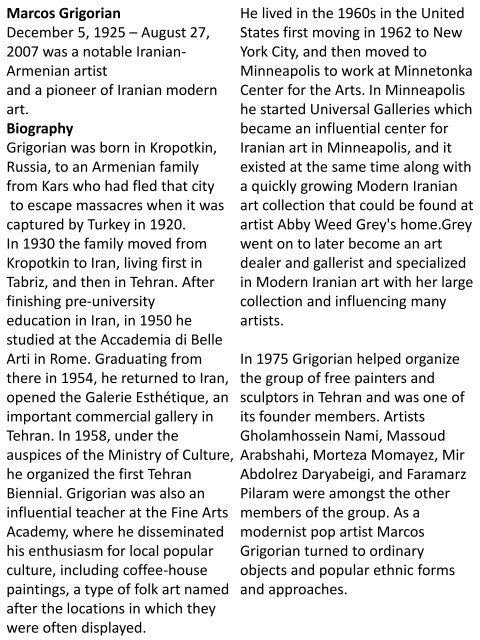Aziz art March 2018
History of art(west and Iranian)-contemporary art-Reza Khodadadi-Alfred Basbous-Marcos Grigorian-Middle East art -surrealism painting -Iranian art auction -Famous Iranian art -middle east artist-Famous iranian artist-humanity-Iranian#Iranian contemporary art -middle east -surrealism painting -visual art -gallery-contemporary art -Qajar art - art auction -exhibition -modern art -London -USA - UK -Aziz Anzabi-Famous Persian artist-painting-art-life-man-woman
History of art(west and Iranian)-contemporary art-Reza Khodadadi-Alfred Basbous-Marcos Grigorian-Middle East art -surrealism painting -Iranian art auction -Famous Iranian art -middle east artist-Famous iranian artist-humanity-Iranian#Iranian contemporary art -middle east -surrealism painting -visual art -gallery-contemporary art -Qajar art - art auction -exhibition -modern art -London -USA - UK -Aziz Anzabi-Famous Persian artist-painting-art-life-man-woman
Create successful ePaper yourself
Turn your PDF publications into a flip-book with our unique Google optimized e-Paper software.
Marcos Grigorian<br />
December 5, 1925 – August 27,<br />
2007 was a notable Iranian-<br />
Armenian <strong>art</strong>ist<br />
and a pioneer of Iranian modern<br />
<strong>art</strong>.<br />
Biography<br />
Grigorian was born in Kropotkin,<br />
Russia, to an Armenian family<br />
from Kars who had fled that city<br />
to escape massacres when it was<br />
captured by Turkey in 1920.<br />
In 1930 the family moved from<br />
Kropotkin to Iran, living first in<br />
Tabriz, and then in Tehran. After<br />
finishing pre-university<br />
education in Iran, in 1950 he<br />
studied at the Accademia di Belle<br />
Arti in Rome. Graduating from<br />
there in 1954, he returned to Iran,<br />
opened the Galerie Esthétique, an<br />
important commercial gallery in<br />
Tehran. In 1958, under the<br />
auspices of the Ministry of Culture,<br />
he organized the first Tehran<br />
Biennial. Grigorian was also an<br />
influential teacher at the Fine Arts<br />
Academy, where he disseminated<br />
his enthusiasm for local popular<br />
culture, including coffee-house<br />
paintings, a type of folk <strong>art</strong> named<br />
after the locations in which they<br />
were often displayed.<br />
He lived in the 1960s in the United<br />
States first moving in 1962 to New<br />
York City, and then moved to<br />
Minneapolis to work at Minnetonka<br />
Center for the Arts. In Minneapolis<br />
he st<strong>art</strong>ed Universal Galleries which<br />
became an influential center for<br />
Iranian <strong>art</strong> in Minneapolis, and it<br />
existed at the same time along with<br />
a quickly growing Modern Iranian<br />
<strong>art</strong> collection that could be found at<br />
<strong>art</strong>ist Abby Weed Grey's home.Grey<br />
went on to later become an <strong>art</strong><br />
dealer and gallerist and specialized<br />
in Modern Iranian <strong>art</strong> with her large<br />
collection and influencing many<br />
<strong>art</strong>ists.<br />
In 1975 Grigorian helped organize<br />
the group of free painters and<br />
sculptors in Tehran and was one of<br />
its founder members. Artists<br />
Gholamhossein Nami, Massoud<br />
Arabshahi, Morteza Momayez, Mir<br />
Abdolrez Daryabeigi, and Faramarz<br />
Pilaram were amongst the other<br />
members of the group. As a<br />
modernist pop <strong>art</strong>ist Marcos<br />
Grigorian turned to ordinary<br />
objects and popular ethnic forms<br />
and approaches.


















